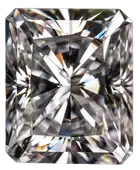 #
#
Gabrielle’s Ideals for Radiant Diamonds
(Table: 62–67% (64.5–67), Depth: 62–68% (66–68.5), Pavilion Depth: 47–56% (50–53), Pavilion Angle: 40–41° (40.2°–41.25°), Crown Angle: 30–45° (steeper the better), Crown Height: 12–15%, Girdle: 2.5–4.5%)
The radiant cut diamond is one of the most versatile diamond shapes, combining the best elements of the round, brilliant, and emerald cut. It features a dazzling brilliant-cut facet structure, similar to a round, but with the rectangular (or square) silhouette and cut-corner profile of an emerald cut. This combination creates exceptional brilliance while maintaining a contemporary, structured appearance.
Invented in 1977 by Henry Grossbard, the radiant cut was designed to maximize brilliance in a square or rectangular shape. It was the first fancy shape to successfully rival the sparkle of a round brilliant. Its crushed ice appearance and sharp light performance make it a modern favorite for those who want strong brilliance with a unique, elongated, or square silhouette.
1. What Is a Radiant Cut Diamond? #
The radiant cut is a hybrid between brilliant and step-cut faceting, giving it an intense sparkle while maintaining structured edges. Unlike the elongated flashes of an emerald cut, a radiant scatters light in multiple directions, creating a fiery, crushed ice effect.
The length-to-width ratio for a radiant cut varies depending on preference:
-
1.00–1.05 for a square radiant.
-
1.20–1.35 for a well-proportioned elongated radiant.
Why Choose a Radiant Cut Diamond?
-
Exceptional Brilliance:
The brilliant-cut facet structure ensures high sparkle and fire, even more than step cuts.
-
More Durable Than Princess Cuts:
With its cut-corner edges, the radiant cut is less prone to chipping compared to sharp-cornered shapes.
-
Versatile Shape Options:
Available in square or elongated forms, offering flexibility for different aesthetic preferences.
-
Hides Inclusions Well:
The scattered brilliance pattern masks inclusions better than step cuts.
-
Larger Face-Up Appearance Than Rounds:
A well-cut radiant can appear larger than a round of the same carat weight due to its elongated shape.
Potential Downsides of a Radiant Cut Diamond
-
Can Show a Bow-Tie Effect:
Some radiants can develop a dark bow-tie shadow across the center, especially if cut too shallow or deep.
-
Crushed Ice vs. Classic Faceting:
Radiants come in different facet styles—some have a true “crushed ice” effect, while others feature more defined facets. The preference is personal, but it affects light performance.
-
Depth Can Reduce Size Appearance:
Radiant cuts can have deep pavilions, which may make them appear smaller than elongated shapes like ovals or emeralds.
-
Requires Precision in Proportions:
If cut too shallow, radiants lose brilliance; if too deep, they face up smaller.
2. The 4Cs for a Radiant Lab Diamond #
While the 4Cs—Cut, Color, Clarity, and Carat—are critical for every diamond, the cut is the most important for radiants, as it directly impacts the light performance.
Cut – The Heart of Radiant Beauty
Getting the cut right means dialing in those key proportions:
-
Table Percentage (IGI’S ideals: 62–67% | Gabrielle’s Ideals: 64.5–67%):
The table is the flat top facet where light first enters. A well-proportioned table ensures that light is evenly dispersed, balancing both fire and brilliance.
-
Depth Percentage (IGI’S ideals: 62–68% | Gabrielle’s Ideals: 66–68.5%):
Depth influences the overall height of the diamond relative to its width. Too shallow, and light escapes; too deep, and light gets trapped, diminishing sparkle.
-
Pavilion Depth (IGI’S ideals: 47–56% | Gabrielle’s Ideals: 50–53%):
The pavilion is the lower portion of the diamond where internal reflections occur. Proper pavilion depth ensures optimal light bounce-back, enhancing overall brightness.
-
Pavilion Angle (IGI’S ideals: 40–41° | Gabrielle’s Ideals: 40.2°–41.25°):
This angle directs light from the table through the diamond. Even slight variations here can significantly affect the interplay between brilliance and scintillation.
-
Crown Angle (IGI’S ideals: 30–45° | Gabrielle’s Ideals: steeper is better):
A steeper crown can boost fire by dispersing light into its colorful spectrum, though it must work in tandem with the other proportions to avoid compromising brightness.
-
Crown Height (12–15%) & Girdle Thickness (2.5–4.5%):
These factors contribute to the overall structure and durability, ensuring that the diamond not only performs optically but also withstands everyday wear.
Pro Tip: A well-cut radiant will have balanced contrast between bright and dark areas, preventing the diamond from looking either too “glassy” or overly dark.
Color – Enhancing the Icy Sparkle
Radiant lab diamonds are cut to deliver a bright, white appearance. Choose the color grade that complements the stone’s natural sparkle:
-
D-F (Colorless): Provides a pristine, icy-white look.
-
G-H (Near Colorless): Offers an outstanding balance between value and that sought-after white brilliance.
-
I-J: It may introduce a slight warmth—ideal if you’re considering a yellow or rose gold setting, which can help balance the tone.
Pro Tip: For settings in yellow or rose gold, selecting an H-J grade can work well, as the metal helps mask any warmth.
Clarity – Focus on Structural Integrity
Lab diamonds usually have fewer inclusions than natural stones. With radiants, look for eye-clean clarity that ensures maximum light performance (in order of our recommendations):
-
VS1–VS2: Often the sweet spot, offering excellent clarity and value.
-
SI1–SI2: Acceptable if inclusions aren’t visible without magnification.
-
VVS1–VVS2: While nearly flawless, these stones come at a premium price and may not be necessary for everyday wear.
-
F-IF: Flawless diamonds exist but are unnecessary for most buyers
Pro Tip: VS1–VS2 is the sweet spot for most radiant diamonds, offering clarity without overpaying.
Carat – More Size for Your Budget
Lab diamonds let you go larger without sacrificing quality. However, a well-cut diamond with ideal proportions will always trump a slightly larger stone that isn’t as balanced.
Pro Tip: Prioritize cut quality over carat size—a perfectly proportioned 1.50 ct radiant can appear larger and more brilliant than a poorly cut 1.75 ct stone.
3. Additional Considerations #
Symmetry & Polish
-
Symmetry: Excellent symmetry ensures the diamond reflects light evenly for an elegant, well-proportioned appearance.
-
Polish: Excellent or very good polish is the best choice to maximize the crispness and cleanliness of the facets.
Fluorescence
-
None or Faint fluorescence is best—strong fluorescence may create haziness in some stones.
Certification
-
Always buy IGI- or GIA-certified diamonds to ensure accurate grading.
Setting Considerations
-
Metal Choice: White gold or platinum enhances the icy brightness of your radiant diamond, while yellow or rose gold can warm the overall look.
-
Setting Style: Prong settings maximize light exposure, ensuring the diamond’s cut is showcased to its full potential.
Final Thoughts #
A well-cut radiant diamond is the perfect mix of structure and sparkle, combining the best elements of a brilliant-cut round and an emerald cut. It’s bright, bold, and durable, making it an excellent choice for those who want a distinctive yet high-performing diamond.
By following Gabrielle’s Ideals, you can confidently select a radiant cut diamond that is proportionally balanced, high-performing, and undeniably stunning.
Happy diamond hunting—may your radiant cut diamond shine as brilliantly as you do!


